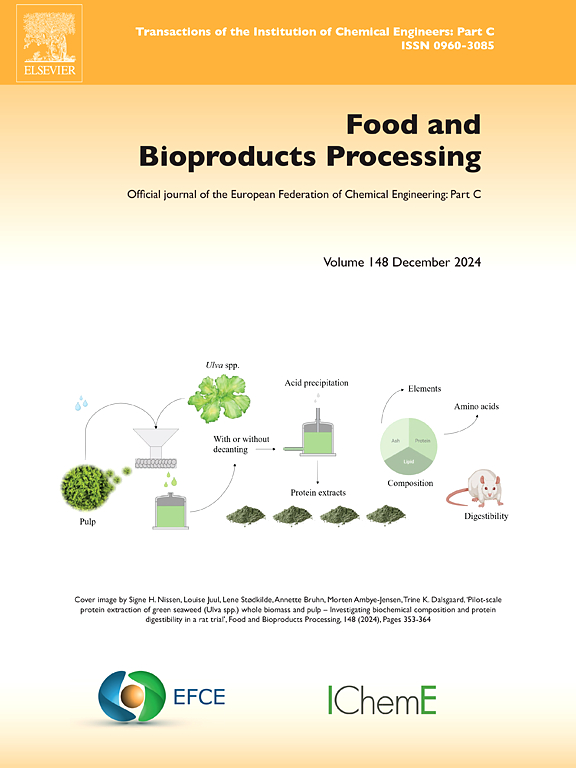高效工业冷冻咖啡萃取液的容器设计优化
IF 3.4
2区 农林科学
Q2 BIOTECHNOLOGY & APPLIED MICROBIOLOGY
引用次数: 0
摘要
冷冻不仅对确保食品安全和延长保质期至关重要,而且对保存食品固有的香气和风味也至关重要。在这项研究中,我们开发并验证了一个现象学模型来模拟工业规模的咖啡提取物冷冻过程。该模型在SfePy中使用有限元方法实现,纳入了温度相关的热物理性质和相变行为。实验验证使用在-25°C冷冻的容器中收集的25公斤咖啡提取物的温度数据进行。模拟温度分布与实验结果吻合较好,均方误差(MSE)为1.32°C2。随后,将验证模型与优化程序相结合,以确定最小冻结时间的最佳容器尺寸。结果表明,增大容器直径和减小容器高度可显著缩短冷冻时间。例如,一个直径为0.8米,高度为0.4米的容器与目前的设计相比,冷冻时间大大减少。与优化程序一起,这个现象学模型作为一个具有成本效益的虚拟工具,支持在咖啡行业设计更有效的冷冻过程,使工程师能够在不产生物理试验成本的情况下测试容器修改和过程条件。本文章由计算机程序翻译,如有差异,请以英文原文为准。
Container design optimization for efficient industrial freezing process of coffee extracts
Freezing is essential not only for ensuring food safety and extending shelf life but also for preserving the intrinsic aroma and flavor profiles. In this study, we developed and validated a phenomenological model to simulate the industrial-scale freezing process of coffee extract. The model was implemented using the finite element method in SfePy, incorporating temperature-dependent thermophysical properties and phase change behavior. Experimental validation was conducted using temperature data collected from a 25 kg coffee extract in a container frozen at –25 °C. The simulated temperature profiles closely matched the experimental results, with a mean squared error (MSE) of 1.32 °C. Subsequently, the validated model was integrated with an optimization routine to determine the optimal container dimensions that minimize freezing time. The results indicate that increasing the container diameter and reducing its height significantly shorten the freezing time. For instance, a container with a diameter of 0.8 m and a height of 0.4 m demonstrated a substantial reduction in freezing time compared to the current design. Together with the optimization program, this phenomenological model serves as a cost-effective virtual tool to support the design of more efficient freezing processes in the coffee industry, enabling engineers to test container modifications and process conditions without incurring the costs of physical trials.
求助全文
通过发布文献求助,成功后即可免费获取论文全文。
去求助
来源期刊

Food and Bioproducts Processing
工程技术-工程:化工
CiteScore
9.70
自引率
4.30%
发文量
115
审稿时长
24 days
期刊介绍:
Official Journal of the European Federation of Chemical Engineering:
Part C
FBP aims to be the principal international journal for publication of high quality, original papers in the branches of engineering and science dedicated to the safe processing of biological products. It is the only journal to exploit the synergy between biotechnology, bioprocessing and food engineering.
Papers showing how research results can be used in engineering design, and accounts of experimental or theoretical research work bringing new perspectives to established principles, highlighting unsolved problems or indicating directions for future research, are particularly welcome. Contributions that deal with new developments in equipment or processes and that can be given quantitative expression are encouraged. The journal is especially interested in papers that extend the boundaries of food and bioproducts processing.
The journal has a strong emphasis on the interface between engineering and food or bioproducts. Papers that are not likely to be published are those:
• Primarily concerned with food formulation
• That use experimental design techniques to obtain response surfaces but gain little insight from them
• That are empirical and ignore established mechanistic models, e.g., empirical drying curves
• That are primarily concerned about sensory evaluation and colour
• Concern the extraction, encapsulation and/or antioxidant activity of a specific biological material without providing insight that could be applied to a similar but different material,
• Containing only chemical analyses of biological materials.
 求助内容:
求助内容: 应助结果提醒方式:
应助结果提醒方式:


